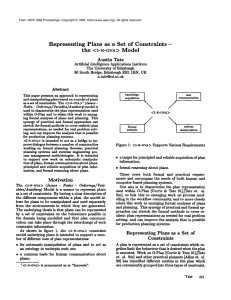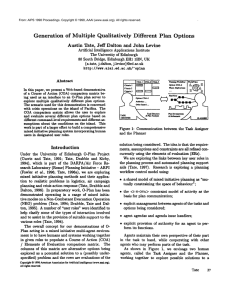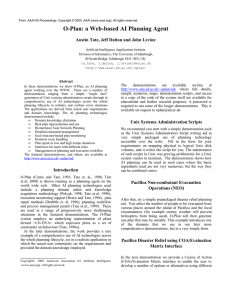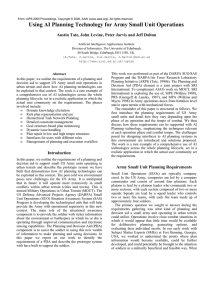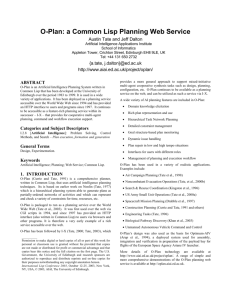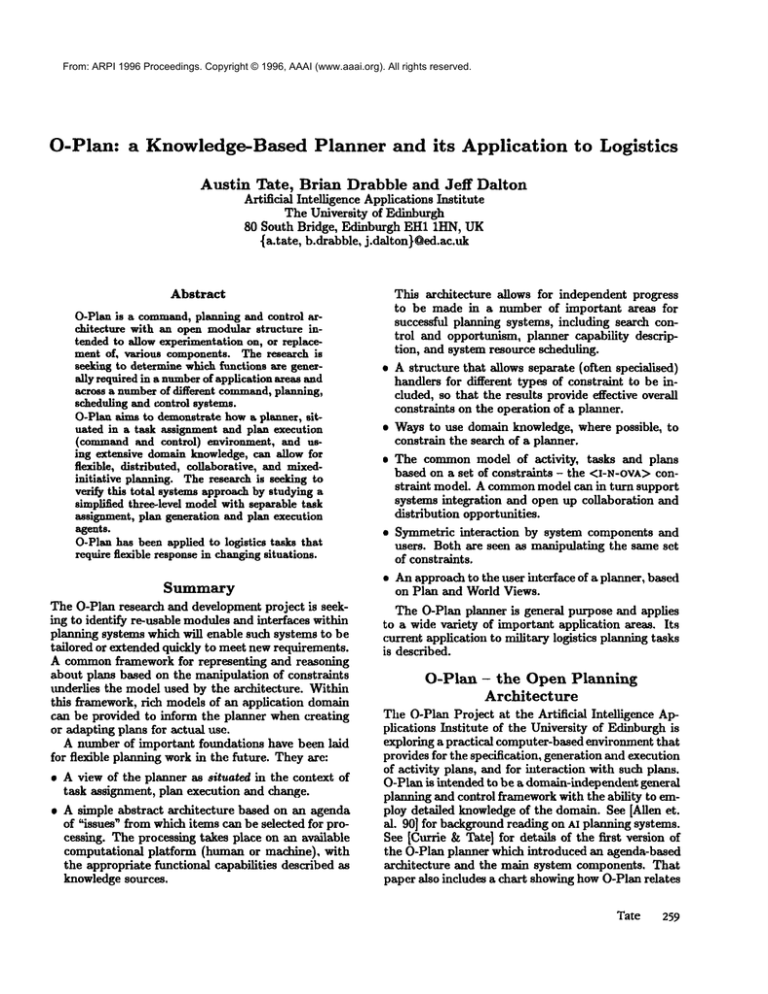
From: ARPI 1996 Proceedings. Copyright © 1996, AAAI (www.aaai.org). All rights reserved.
O-Plan:
a Knowledge-Based Planner and its
Austin
Application
to Logistics
Tate,
Brian Drabble
and Jeff
Dalton
Artificial Intelligence Applications Institute
The University of Edinburgh
80 South Bridge, Edinburgh EH1 1HN, UK
~a.tate, b.drabble, j.dalton)Qed.ac.uk
Abstract
O-Plan is a command,planning and control architecture with an open modular structure intended to allow experimentation on, or replacement of, various components. The research is
seeking to determine which functions are generally required in a numberof application areas and
across a numberof different comm~nd,p]a,n|ng,
scheduling and control systems.
O-Plan alms to demonstrate howa planner, situated in a task assignment and plan execution
(commandand control) environment, and using extensive domain knowledge, can allow for
flexible, distributed, collaborative, and mixedinitiative planning. The research is seeking to
verify this total systems approach by studying a
simplified three-level modelwith separable task
assignment, plan generation and plan execution
agents.
O-Plan has been applied to logistics tasks that
require flexible responsein changingsituations.
Summary
The O-Plan research and development project is seeking to identify re-usable modules and interfaces within
planning systems which will enable such systems to be
tailored or extended quickly to meet new requirements.
A commonframework for representing and reasoning
about plans based on the manipulation of constraints
underlies the model used by the architecture. Within
this framework, rich models of an application domain
can be provided to inform the planner when creating
or adapting plans for actual use.
A number of important foundations have been laid
for flexible planning work in the future. They are:
¯ A view of the planner as situated ill the context of
task assignment, plan execution and change.
¯ A simple abstract architecture based on an agenda
of "issues" from which items can be selected for processing. The processing takes place on an available
computational platform (human or machine), with
the appropriate functional capabilities described as
knowledge sources.
This architecture allows for independent progress
to be made in a number of important areas for
successful planning systems, including search control and opportunism, planner capability description, and system resource scheduling.
¯ A structure that allows separate (often specialised)
handlers for different types of constraint to be inchided, so that the results provide effective overall
constraints on the operation of a planner.
¯ Ways to use domain knowledge, where possible, to
constrain the search of a planner.
¯ The commonmodel of activity,
tasks and plans
based on a set of constraints - the ~I-N-OVA~constraint model. A commonmodel can in turn support
systems integration and open up collaboration and
distribution opportunities.
¯ Symmetric interaction
by system components and
users. Both are seen as manipulating the same set
of constraints.
¯ An approach to the user intcrface of a planner, based
on Plan and World Views.
The O-Plan planner is general purpose and applies
to a wide variety of important application areas. Its
current application to military logistics planning tasks
is described.
O-Plan
- the Open Planning
Architecture
The O-Plan Project at the Artificial Intelligence Applications Institute of the University of Edinburgh is
exploring a practical computer-based environment that
provides for the specification, generation and execution
of activity plans, and for interaction with such plans.
O-Plan is intended to be a domain-independent general
plazming and control frameworkwith the ability to employ detailed knowledgeof the domain. See [Allen st.
al. 90] for background reading on AI planning systems.
See [Currie & Tats] for details of the first version of
the O-Plan planner which introduced an agenda-based
architecture and the main system components. That
paper also includes a chart showing howO-Plan relates
Tate
259
From: ARPI 1996 Proceedings. Copyright © 1996, AAAI (www.aaai.org). All rights reserved.
to other planning systems. The second version of the
O-Plan system adopted a multi-agent approach and
situated the planner in a task requirement and plan execution setting [Drabble & "late 95]. The multi-agent
approach taken is described in greate$ detail in [Tate
et. al. 94b].
STRATEGIC
AnMysis/Direction
TACTICAL
Plannlng/Scheduling
OPERATIONAL
Enactment/Cont rol
Figure 1: CommunicationbetweeJa Strategic,
and Operational Agents
Tactical
Figure 1 shows the communications between the 3
agents in the O-Plan architecture 1. A user specifies a
task that is to be performed through some suitable interface. Wecall this process task assignment. A planner plans to perform the task specified. The ezecution
system seeks to carry out the detailed actions specified by the planner while working with a more detailed
model of the execution environment. The activities of
the three agents may be more or less concurrent.
The O-Plml approach to command, planning,
scheduling and control can be characterised as billows:
¯ successive refinement/repair of a complete plan or
schedule which contains an agenda of outstmlding
issues:
¯ a least commitment approach;
¯ opportunistic selection of the focus of attention on
each problem-solving cycle;
¯ incremental tightening of constraints on the plml,
performed by "constraint managers", e.g.,
- time point network manager,
- object/variable manager,
- effect/condition manager,
- resource utilisation manager;
¯ localised search to explore alternatives where oxlvisable;
¯ global alternative re-orientation where necessary.
The O-Plan project has sought to identify modular
components within an AI comma~ld: planning and control system and to provide clearly defined interfaces
1This simplified view of the environment within which
a planner operates helps to clarify the O-Planresearch objectives. It is sufficient to ensure that the tasking and execution environmentsare represented.
260
ARPI
to these components. The background to this work is
provided in [’late 93b]. Tlie various componentsplug
into %ockets" within the architectural framework. The
sockets are specialised to ease the integration of particular types of component.See figure 2.
Figure 2: O-Plan Agent Architecture
The components that plug into the O-Plan agent
ardfitecture are:
PlanWorld Viewers - User interface,
visualisation
and presentation viewers for the plan - usmdlydiffercntiated into technically oriented plan views (charts,
structure diagrams: etc.) and domain oriented ~oorld
views (simulations, animations, etc.).
Knowledge Sources Functional components which can analyse, synthesise or modify tflans. They provide the capabilities
of the agent.
Domain Library - A model of the domain, including a library of possible a~:tions. Different models
or levels of detail of the model are possible within
different agents.
Constraint
Managers - Components which manage
detailed constraints within a plan and seek to maintaln as accurate a picture as possible of the feasibility of the current plan with respect to the domain
model.
These plug-in components are orchestrated by an OPlan agent kernel which carries out the tasks assigned
to it via appropriate use of the KnowledgeSources and
manages options being maintaim.,d within the agent’s
Plan 8tare. The roles of the componentsare as follows:
Interface Manager - Hmldles external events (re~
quirenmnts or reports) a~ld, if they can be processed
by the agent, posts them on the agent Agenda.
Controller - Chooses Agenda entries
by suitable KnowledgeSources.
for processing
Knowledge Source Platform(s)
- Chosen Knowledge Sources are run on an available and suitable
Knowledge Source Platform.
Data Base Manager- .Maintains
the Plan State
mid provides services to the Interface Mazmger.Controller and KnowledgeSources.
From: ARPI 1996 Proceedings. Copyright © 1996, AAAI (www.aaai.org). All rights reserved.
Constraint Associator Acts as a mediator between
changes to the Plan State made by the Data Base
Managerand the activities of the various Constraint
Managersthat are installed in the agent. It eases the
managementof interrelationships
between the main
plan entities and detailed constraints [’rate et. al.
94c].
A Situated Planner - Coordinating
Task Assignment, Planning and Plan
Execution
The O-Plan project has identified the need for AI planners to be viewed as situated in an environment where
planning is one of a number of tasks involved in dealing with the whole problem of task assignment, planning, execution and control. While the planner deals
with the plan generation aspect of the problem, other
agents may deal with task elicitation, plan analysis,
reactive execution, plan repair, etc. Each of these systems has its own perspective on the planning problern
and each is capable of communicating in a way which
allows other systems to assimilate new information into
their perspective of the problem. This view of planners
introduces a numberof new issues: the role of authority, determining the quality of the plans being generated by other systems and controlling the execution of
plans within other situated agents.
The activities of the various agents need to be coordinated, and authority management is viewed as one
way in which this can be done [Tate 93a]. For example, in plan generation, it maybe necessary to be given
authority to work on certain options and to have direction on the level of detail to which a plan should
be developed. In plan enactment, it is important to
identify (and possibly name) wtfich phases of the plans
can be executed and which parts should be held back
for further approval.
Current AI planners can generate a solution that satisfies the requirements they are given. Someplanners
provide facilities to control the quality of the solution
to be returned, by using evaluation functions or searchcontrol rules. However, they do not usually integrate
plan quality considerations across several plans. In addition, their plan representations may not reflect the
plan quality criteria that are necessary in practice. To
date the O-Plan system is able to generate plans and
communicatethenl to the ]~XPECT
[Gil 94],[Gil et. al.
94] system for evaluation. Workis continuing to expand the interface between ~.XPECTand O-Plan to
strengthen the support for users in specifying, comparing and refining the constraints on a range of different
plan options, at the task assignment level of a planning
support environment, and to allow this information to
be used directly by O-Plan in guiding it in its search
for a good solution.
The O-Plan architecture has been designed to support the creation of agents which are situated in an en-
vironment involving communication with other agents,
and work to date has concentrated on building generative planning agents and execution agents, with links
between them. The results of this research have been
used in a number of systems that have drawn on the
O-Plan work. For example, the Optimum-AIV[Aarup
et. al. 94] system, developed for Assembly,Integration
and Verification of spacecraft at the European Space
Agency, and now in use for Ariane Launcher preparations, uses concepts from O-Plan’s plan representation
to support the repair of plans to deal with test failures. As part of the O-Plan research, an associated
Ph.D student project explored the creation of a reactive execution agent within the O-Plan agent architecture [Reece 94]. This work also showed the value of
using the plan intentions captured in Goal Structure
to support effective reactive execution and re-planning
[Reece &Tate 94].
Using Domain Knowledge in Planning
O-Plan provides the ability to use domain knowledge about time constraints,
resource requirements
and other features to restrict the range of plans being
considered as feasible solutions to the tasks specified.
The O-Plan research programme has studied a number of mechanisms for using such knowledge to prune
or prioritise search. These include using temporal constraints [Bell &Tate 85],[Drabble &Kirby 91], resource
constraints [Drabble & Tate 94], temporal coherence of
conditions [Drummond& Currie 89], and Goal Structure condition type information [’late 75],[Tare 77].
¯ Temporal Constraints - Each time point referred
to in a plan is constrained to have an upper and
lower bound on its temporal distance from other
time points and from time ~zero". The time points
held in the Time Point Network (TPN) are indirectly
linked to actions and events in a plan - which we refer
to as theAssociated
DataStructure
(ADS) [Drabble
& Kirby 91]. This ensures that the TPNand entities
represented in the ADScan both be independently
changed. In addition, the functional interface to the
TPNdoes not reveal the underlying representation,
so that a different way of handling time constraints
could be substituted.
¯ Object/Variable
Constraints
- O-Plan uses a
rich model of constraints to handle the interactions
and dependencies among the different objects and
variables, including co-designation (equality), noncodesignation (inequality), scalar (set membership),
and numeric range constraints.
¯ Resource Constraints - O-Plan uses a rich model
to manage the detailed resource constraints within
a plan. The Resource Utilisation
Manager (RUM)
[Drabble & Tate 94] can handle a number of different resource types and can reason about how resource levels change during the generation of a plan.
There are two major resource types supported by the
Tare
261
From: ARPI 1996 Proceedings. Copyright © 1996, AAAI (www.aaai.org). All rights reserved.
RU~: consumable resources and reusable resources.
Each of these can be further subdivided to model
the resources of the domain.
¯ Goal Structure
and Condition
Types - One
powerful means of using domain knowledge to restrict and guide search in a planner is to recognise
explicit prec.ondition types: as introduced into Interplan [T~te 75] and Nonlin [T~te 77] ~ld subsequently used in other systems such as Deviser [Vere
81], SIPE-2 [Wilkins 88], and O-Plan [Currie &
Tate],[Tate et. al. 94b]. O-Plan and Nonlin Task
Formalism (TF) extends the notion of a precondition
~
on an action and mates it with a "process-oriented
view of action descriptions. A TF schemadescription
specifies a method by which somehigher level action
can be performed (or higher level goal achieved).
detailed description of the use of condition types to
inform search in an AI plmmer is provided in [rate
et. ai. 94a]. That paper also compares the use of
condition types in O-Plan with a number of other
planners.
<I-N-OVA>- Manipulating Plans as a
Set of Constraints
The ~I-N-OVA> 2 (Issues - Nodes - Orderings/Variables/Auziliary) Model is a means to represent plmls
as a set of constraints [Tate 95],[Tale 96]. By having
a clear description of the different componentswithin
a plan, the model allows for plans to be mmdpulated
madused separately to the enviromnents ill which they
are generated.
Our aim is to characterise the plml representation
used within O-Plan [Currie & Tate],[Tate et. al. 94b]
and to relate this work to emerging formal analyses
of plans mad planning. This synergy of practical mid
formal approaches can stretch the formal nmthods to
cover realistic plan representations, as needed for rcai
problem solving, and can improve the analysis that is
possible for production planning systems.
A plml is represented as a set of constraints which
together limit the bchaviour that is desired when the
plan is executed. Work on O-Plml mid other practical planners has identified different entities in the plan
which are conveniently grouped into three types of constraint. The set of constraints describes the possible
plan elaborations that can be retu:hed or generated as
shownill figure 3.
The three types of constraint in a plml are:
1. Implied Constraints or "Issues" - the pending or future constraints that will be added to the plan as a
result of handling unsatisfied requirements, dealing
with aspects of plml analysis and critiquing, etc. The
implied constraints are the issues to be addressed,
i.e., the ~to-do~ list or agenda which can be used to
decide what plan modifications should be Ingle to a
plan by a planner (user or system).
2~I-N-OVA> ".
is pronouncedas in "Innovate
262
ARPI
Plan State
Implied
Constraints
Plan Level
Constraints
Detailed
Constraints
[
I
Plan Agenda
!
I Plan Entities
I
I Plan Constraints [
"~
/Space of Legitimate
Plan Elaborations
Figure 3: Plan Constraints Define Space of Plan Elaborations
.
,
Plan Entities or Plan Node Constraints the main
plan entities related to external communication of
a plan. They describe a set of external names associate~i to time points. In an activity planner, the
nodes are usually the actions in the plan associated
with their begin and end tinm points. In a resourcecentred scheduler, nodes may be the resource reservations made against the available resources with a
begin a~ld end time point for the reservation period.
Detailed Constraints specialised constraints on the
plan associated with plan entities. Empirical work
on the O-Plan planner has identified the desirability
of distinguishing two special types of detailed constraint: Ordering or Temporal Constraints (such as
temporal relationships between the nodes or metric time properties); and Variable Constraints (codesignation and non-co-designation constraints on
plml objects in particular).
Other Detailed Constraints relate to input (pre-) and output (post-)
protection conditions: resources, anthority requirements, spatial constraints, etc. These are referred
to as Auziliary Constraints.
Abstract View of the O-Plan Control
Flow
O-Plan operates on a workflow principle, being driven
by an agenda of "issues ~. It is useful to present a simple abstraction of the workflow within such systems.
()-Plan refines a "current state "~. It maintains one or
nmre options within the state for alternative decisions
about how to restrict the space of state elaborations
which can be reached 3. The system needs to know
what outstanding processing requirements exist in the
3State constraint
relaxation
is also possible
to increase
the space of state elaborations in somesystems.
From: ARPI 1996 Proceedings. Copyright © 1996, AAAI (www.aaai.org). All rights reserved.
i
Pl.~id
|"’"t;~’"l-’mi~""l~’H’]’~’C~
O-fle~
III
II
Him II
Ill
O-P]l~
14 li
I~-P]~
~ ~..~
M I
m-mole
II
1oliln
Figure 5: Example Output of the PianWorld Viewer User Interface
state -- the Agenda oJ Issue& These represent the hnpEed constraints on valid future states. One (normally)
of these outstanding processing requirements is chosen
to be worked upon next (by the Controller). This calls
up processing capabilities (Knowledge Sources or Issue
Handlers) within the system which can make decisions
and modify the State. The modifications can be in
terms of definite changes to entities in the state or by
noting further processing requirements (as a result of
state analysis and critiquing: etc.) on the agenda.
Wehave found it useful to separate the entities
representing the decisions already made during processing into a high level (representing the main entities shared across all planning system components
and known to various parts of the system), and more
detailed specialised entities (which form a specialised
area of the representation of the plan state). These
lower level, more compartmentalised, parts can represent specialised constraints within the plan state such
as time, resource, spatial and other features. This sep-
aration can assist in the identification of opportunities
for modularity within the system.
Working with the User
O-Plan is implemented in CommonLisp on Unix
Workstations with an X-Windowsinterface. It is designed to be able to exploit distributed and multiprocessor delivery systems in future. An interface to
AutocADhas been built to show the type of User Interface we envisage (see Figure 5). This is called the
PlanWorld Viewer Interface [~te & Drabble 95]. The
windowin the top left comer shows the Task Assignment menu and supports the management of authority
[Tare 93a] to plan and execute plans for a given task.
The lower window shows a Plan View (such as a graph
or a gantt chart), and the upper right windowshows
a World View (for visualisation or simulations of the
state of the world at points in the plan). The particular plan viewer and world viewer provided are declared
to tile system and the interfaces between these and tile
Tate
263
From: ARPI 1996 Proceedings. Copyright © 1996, AAAI (www.aaai.org). All rights reserved.
planner uses a defined interface to which various implementations can conform. O-Plvai has been interfaced
to a number of Plan and World Viewers including process modelling tools, map-based interfaces and tools
that create animation sequences of possible plan execution. The developer interface to O-Plazl is not shown
to the normal planner user.
Recent work on ()-Plan has focussed on the representation and managementof constraints in planning,
particularly in order to simplify someaspects of the architecture and to act as a mechanism for user/system
mixed-initiative planning [Tate 94].
Target Applications
for O-Plan
O-Plan is aimed at the following types of problems:
¯ project management, systems engineering, construction, process flow, integration and verification, etc.
¯ planning and control of supply and distribution logistics.
¯ mission sequencing and control of space probes and
satellites such as VOYAGER,
ERS-1, etc.
These applications fit midway between the largescale manufacturing scheduling problems found in
some industries (where there are often few interoperation constraints) and the complex puzzles dealt
with by very flexible logic-based tools. However, the
problems of the target type represent an important
class of industrial, scientific and engineering relevance.
The architecture itself has wider applicability. For
example, it has been used as tile basis for the design
of the TOSCA
manufacturing scheduler in a project for
Hitachi [Beck 93].
Crisis
Action Planning
The application emphasis of the O-Plan project has
been to aid in the defllfition, generation and enactment
of Courses of Action (COAs)within the military crisis
action planning process. There are six phases identified
ill reponding to a crisis are shownin the table.
Phase 1 Situation Development
Phase 2 Crisis Assessment
Phase 3 COADevelopment: O-Plan provides support in tile development of COAsmid in
estimating the feasibility of the generated
COAS.This is the main contribution of
the project.
Phase 4 COASelection: O-Plan provides support
in the refinement and presentation
of
COAs.
Phase 5 Execution Plamfing
Phase 6 Execution
The O-Plan research principally axldresses phases
three through six. AIAI has also worked with a mlmber
of groups on the representations of plans which ca~l be
264
ARPI
used to communicate across the different phases and
agents involved in the crisis planning process.
Crisis action planning has provided the focus for recent O-Plan applications with problems being tested
in the PRECISdomain [Reece et. al. 93] and a simplified version of Integrated Feasibility Demonstration
scenario number 2 (IFD-2) from the ARPA/B.omeLaboratory Planning Initiative [Fowler et. al. 95]. These
test domainsallow for re,’distic, and nfilitary-relevant,
scenarios and issues to be addressed in a setting suitable for research and development. Crisis action planning calls for plans to be developed which are flexible, robust and responsive to changing task requirements and changes in the operational situation. Current planning aids are too inflexible.
Current military planning systems usually allow oldy
one COAto be fully thought through, and any alternatives are seen as poor relations. This is due to the
fixed-step nature of the process: it is not viewed as
¯ "miterative process in which several sources of knowledge mid tedmiques (e.g., tasking, planning, scheduling, resourcing and repairing) can be brought in as and
when required. A more flexible planning framework
mayallow military planners to be freed from a step-bystep approach to consider more options and constraints
where appropriate within the planning process.
PRECiS/Pacifica
Domain
The principal development of O-Plan has been motivated by applications related to logistics, transportation planning/scheduling
problems and Noncombatazlt Evacuation Operations (NEOs).
The
testbed is provided by the PRECIS(Planning. Reactive
Execution and Constraint Satisfaction) environment.
It defines the data and hypothetical background for
logistics planning and reacting scenarios which can be
used for demonstration and evaluation purposes.
Tilt" definition of the PRECISenvh’onmenthas drawn
on work by several people: Brown at Mitre Corporation to describe a realistic NEOscenario for the Planning Initiative’s Integrated Feasibility Demonstration
Nmnber3 (IFD-3); Reece and Tate to define a~l openly
accessible fictional environment based on the island of
Paciflca [Reece & Tare 93] suitable for enabling technology researchers interested in planning and reactive
execution of plans; anti Hoffman and Bumard at Isx
Corporation to produce a cut-down demonstration scenario suitable for transportation sc/mduling research
experiments within the ARPA/rtomeLaboratory Planning and Scheduling hfitiative. The results have been
provided in a publicly available document [Reece et.
al. 93] and other materials.
Four primary needs of the ARPA/P~HIe Laboratory
Plmming and Scheduling Initiative
are met by the
PRECISenvironment.
1. Realistic scenarios can be explored from the data
provided in the environment for COAgenerative planning, case based reasoning, trmlsportation
From: ARPI 1996 Proceedings. Copyright © 1996, AAAI (www.aaai.org). All rights reserved.
scheduling and the reactive execution of plans.
2. Requirements of ~tier-1 ~ enabling researchers are
sufficiently met by the data in order for thexn to
pursue their individual research programmes.
3. Entities in the environment are hypothetical and do
not reflect actual peoples and locations, yet are realistic in the types of data that would normally be
available.
4. The scenario
fidential or
demonstrated
them. This is
and domain descriptions are not conmilitary critical. They can be openly
and publications can be based upon
important for enabling researchers.
Work on the PREcis environment and the Pacifica
island model has continued. Map viewers and simulators are now available for demonstration and evaluation purposes. O-Plan has been demonstrated developing Non-combatant Evacuation Operation (NEO) plans
in this environment and a reactive execution agent
(REA) based on the O-Plan architecture has been used
to reactively modify plans to respond to operational
demandsin a simulation of the Pacifica island in the
context of a NEO.
[Bell &Tare 85] Bell, C.E. and Tate, A., Using Temporal Constraints to Restrict Search in a Planner, Paper
presented to the Third UK Planning SIG Workshop,
Sunningdale, Oxon, UK. Proceedings published by the
Institution of Electrical Engineers, London, January
1985.
[Currie & Tare 91] Currie, K.W. and Tare, A., O-Plan:
the OpenPlanning Architecture, Artificial Intelligence
52(1), pp. 49-86, North-Holland, 1991.
[Drabble & Kirby 91] Drabble, B. and Kirby, R., Assodating A.I. Planner Entities with an Underlying Time
Point Network, Proceedings of the First European
Workshop on Planning (EWSP-91), Springer-Verlag
Lecture Notes in Artificial Intelligence No 522, 1991.
[Drabble &Tate 94] Drabble, B. and Tare, A., The Use
of Optimistic and Pessimistic Resource Profiles to Inform Search in an Activity Based Planner, Proceedings
of the Second International Conference on AI Planning
Systems (AIPS-94), AAAIPress, Chicago, USA, June
1994.
[Drabble & Tare 95] Drabble, B. and Tate, A., O-Plan:
A Situated Planning Agent, Proceedings of the Third
European Workshop on Planning (EWSP’95), Assisi,
Italy, September, 1995. In NewDirections in Planning,
Acknowledgements
(eds. Ghallab. M. and Milani, A.), Frontiers in AI and
Applications Series, No. 31, IOS Press, Amsterdam,
The O-Plan project is sponsored by the Advanced
1995.
Research Projects Agency (ARPA) and Rome Laboratory, AirForceMateriel
Command,
USAF,undergrant
[Drummond & Currie 89] Drummond, M. and Currie,
numberF30602-95-1-0022.
The O-Planprojectis
K. Exploiting Temporal Coherence in Nonlinear Plan
monitoredby Dr. NorthrupFowlerm at the USAF
Construction, in Proceedings of the International Joint
RomeLaboratory.
The u.s.Government
is mlthorised
Conferenceon Artificial Intelligence IJCAI-89, Detroit,
to reproduce
anddistribute
reprints
forGovernmen- USA, 1989.
talpurposes
notwithstanding
anycopyright
annotation [Fowler et. al 95] Fowler, N., Cross, S.E. and Owens,
hereon.The viewsand conclusions
contained
herein
C. The ARPA-RomeKnowledge-Based Planning and
arethoseof themxthors
andshould
notbe interpreted Scheduling Initiative,
IEEE Expert: Intelligent Sysasnecessarily
representing
official
policies
or endorse- tems and their Applications, Vol. 10, No. I, pp. 4-9,
ments,eitherexpress
or implied,
of ARPA,RomeLabFebruary 1995, IEEE Computer Society.
oratoryor the u.s.Government.
[Gil 94] Gil, Y. Knowledge Refinement in a Reflective Architecture, in the proceedings of the Twelfth
References
National Conferenceon Artificial Intelligence, Seattle,
WA, USA. August 1994. Published by AAAIPress/
[Aarup et. al. 94] Aarup, M., Arentoft, M.M., Parrod,
The MIT Press Menlo Park, CA, USA.
Y., Stokes. I., Vadon, H. and Stader, J. OptimumAIV: A Knowledge-Based Planning and Scheduling
[Gil et. al. 94] Gil, Y., Tare, A. and Hotfman, M.,
System for Spacecraft All/, in Intelligent Scheduling
Domain-Specific Criteria to Direct and Evaluate Plan(eds. Zweben, M. and Fox, M.S.), Morgan Kaufmann,
ning Systems, Proceedings of the ARPA/RomeLabSan Francisco, 1994.
oratory Planning Initiative Workshop, (ed. Burstein,
M.),
Morgan Kaufmann, 1994.
[Allen et. al. 90] Allen, J., Hendler, J. and "l~,tte, A.,
Readings in Planning, Morgan Kaufmann, Pals Alto,
[Reece 94] Reece, G.A., Characterization and Design of
1990.
Competent Rational Execution Agents for Use in Dynamic Environments, Ph.D Thesis, Department of Ar[Beck93l Beck, H., TOSCA:A Novel Approach to the
tificial Intelligence, University of Edinburgh, NovemManagementof Job-shop Scheduling Constraints,
ber 1994.
alising CIM’sIndustrial Potential: Proceedings of the
Ninth CIM-Europe Annual Conference, pages 138-149,
[Reece & Tare 93] Reece, G.A. and Tare, A. The
(eds. Kooij, C., MacConaill, P.A., and Bastos, J.)..
Pacifica NEOScenario, Technical Paper ARPA-RL/O1993.
Tam 265
From: ARPI 1996 Proceedings. Copyright © 1996, AAAI (www.aaai.org). All rights reserved.
Plan/TP/3, March 1993.
[Reece et. al. 93] Reece, G.A., Tatc, A., Brown,D. mid
Hoffman, M., The PRECIS Enviromnent, Paper presented at the ARPA-RLPlanning Initiative
Workshop
at AAAI-93, Washington D.C., July 1993. Also available as University of Edinburgh, Artificial Intelligence
Applications Institute Technical Report AIAI-TR-140.
[Reece ~z "rate 94] Reece, G.A. and Tate, A., Synthesizing Protection Monitors from Causal Structure, Proceedings of the Second International Conference on AI
Planning Systems (AIPS-94), AAAIPress, Chicago,
USA, June 1994.
[’late 75] "rate, A., Using Goal Structure to Direct
Search in a Problem Solver. Ph.D. Thesis, University
of Edinburgh, 1975.
[’rate 77] Tate, A., Generating Project Networks, Proceedings of the International Joint Conference on Artificial Intelligence (IJCAI-77), Cambridge, Mass., USA,
1977.
[Tare 93a] Tare, A., Authority Management - Coordination between Planning, Scheduling and Control,
Workshop on Knowledge. based Production Planning,
Scheduling and Control at the International Joint Conference on Artificial Intelligence (IJCAI-93), Chambery. France, 1993.
[Tare 93b] Tare, A., The Emergence of "Standard"
Planning and Scheduling System Components, in Current Trends in AI Planning, (eds. BackstrSm, C.
Sandewall, E.), IOS Press, 1993.
[Tare 94] Tare, A., Mixed Initiative Planning in OPlva12, Proceedings of the ARPA/RoIneLaboratory
Planning Initiative Workshop,(cd. Burstein, M.), "Sacson, Arizona, USA, Morgan Kaufmann, 1994.
[’rate 95] Tate, A. Characterising Plans as a Set of
Constraints
the <I-N-OVA> Model - a Framework
for Comparative Analysis, Special Issue on ~Evaluation of Plans, Planners, and Planning Agents", ACM
SIGARTBulletin Vol. 6 No. 1, January 1995.
[Tare 96] Tare, A. Representing Plans as a Set of Constraints - the <I-N-OVA>Model, Proceedings of the
Third International Conference on Artificial Intelligence Planning Systems (AIPS-96), Edinburgh, UK,
AAAIPress, May 1996.
[Tare & Drabble 95] Tare. A. and Drabblc, B., PlanWorld Viewers. Proceedings of the 14th Workshop
of the UKPlanning and Scheduling Special Interest
Group, Colchester, UK, November 1995.
[Tate et. al. 94a] Tare, A., Drabble, B. and Dalton,
J., ~The Use of Condition Types to Restrict Search in
val AI Planner" Proceedings of the Twelfth National
Conference on Artificial Intelligence (AAAI-94), Seattie, USA, August 1994.
[Tare et. al. 94b] Tare, A., Drabble, B. and Kirby,
R.B., O-Plan2: an Open Architecture for Command,
266
ARPI
Planning and Control, in Intelligent Scheduling (eds.
Zweben, M. and Fox, M.S.), Morgan Kaufmann, San
Francisco, 1994.
[Tare et. al. 94c] "rate, A., Drabble, B. raid Dalton, J.
Reasoning with Constraints within O-Plan2, Proceedings of the ARPA/Rome
Laboratory Planning Initiative Workshop, (ed. Burstein, M.), Tucson, Arizona,
USA, Morgan Kaufmann, 1994.
[Vere 81] Vere: S. Planning in Time: Windows and
Durations for Activities and Goals, IEEE Transactions
on Pattern Analysis and Machine Intelligence Vol. 5,
1981.
[Wilkins 88] Wilkins, D. Practical Plauning, Morgan
Kaufmann, Palo Alto, 1988.

